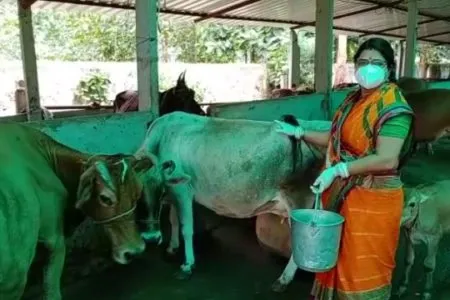Dairy farming in India
Dairy farming in India is a cornerstone of the country's agricultural economy, playing a vital role
in nutrition, employment, and rural development. India is the largest producer and consumer of
milk globally, contributing significantly to the global dairy market and its own national economy.
Key Highlights of Dairy Farming in India:
Economic Importance:The dairy sector contributes approximately 5% to India's national economy and employs
over 80 million farmers directly .
1 2
With a market size of INR 16,792.1 billion in 2023, the Indian dairy industry is projected to
grow at a compound annual growth rate CAGR) of 13%, reaching INR 49,953.5 billion by
2032 .
1
Milk production in India grew from 187.3 million tonnes in 2018-19 to an estimated 236.35
million tonnes in 2023-24, with a CAGR of around 6% .Production and Consumption
India accounts for about 25% of global milk production, with per capita availability at 459
grams per day, significantly higher than the global average of 322 grams per day .
2
The country has a vast livestock population of over 300 million bovines, including
indigenous breeds like Sahiwal and Gir as well as crossbred and exotic breeds such as
Holstein Friesian and Jersey .
3
Buffaloes contribute nearly half of India's milk production, followed by cows and goats .
3
Cooperative Movement
Cooperatives like Amul and Mother Dairy have been instrumental in organizing dairy
farmers, ensuring fair pricing, and providing infrastructure and marketing support .
4 2
There are over 230,000 villages involved in cooperative dairy activities, with approximately
18 million farmers as members. Women play a significant role, constituting about 35% of
cooperative members .
Government Support:The Indian government has implemented various policies to boost dairy farmingPrograms like the National Dairy Plan, Rashtriya Gokul Mission, and Dairy Entrepreneurship
Development Scheme aim to improve productivity and infrastructure .
4
Despite its success, the Indian dairy sector faces several challenges:
The Indian dairy industry is poised for robust growth due to increasing domestic demand driven
by population growth, rising incomes, and changing dietary preferences. The focus on
modernizing infrastructure, promoting high-yielding breeds, and empowering rural farmers
through cooperatives will further strengthen this sector.
In summary, dairy farming in India is not just an economic activity but also a means of socioeconomic transformation for millions of rural households. With continued investment and
innovation, it holds immense potential for sustainable growth.
⁂
Foreign Direct Investment FDI) is allowed up to 100% in animal husbandry and food
processing sectors .
4
Regulatory bodies such as the Department of Animal Husbandry and Dairying DAH&D)
oversee the sector's development . Challenges:Despite its success, the Indian dairy sector faces several challenges:
The Indian dairy industry is poised for robust growth due to increasing domestic demand driven
by population growth, rising incomes, and changing dietary preferences. The focus on
modernizing infrastructure, promoting high-yielding breeds, and empowering rural farmers
through cooperatives will further strengthen this sector.
In summary, dairy farming in India is not just an economic activity but also a means of socioeconomic transformation for millions of rural households. With continued investment and
innovation, it holds immense potential for sustainable growth.
⁂
Foreign Direct Investment FDI) is allowed up to 100% in animal husbandry and food
processing sectors .
4
Regulatory bodies such as the Department of Animal Husbandry and Dairying DAH&D)
oversee the sector's development .
3
Challenges
1. Feed Shortages: There is a significant deficit in quality fodder—23.4% for dry fodder and
11.24% for green fodder—which affects milk yield .
4
2. Low Productivity: Indigenous cattle produce less milk compared to crossbred or exotic
breeds; however, their milk is considered nutritionally superior .
3
3. Fragmented Farming: Most dairy farms are small-scale operations with fewer than ten
animals, limiting economies of scale .
3
4. Awareness Gap: Many farmers lack knowledge about modern dairy farming techniques that
could enhance productivity. Future Outlook:The Indian dairy industry is poised for robust growth due to increasing domestic demand driven
by population growth, rising incomes, and changing dietary preferences. The focus on
modernizing infrastructure, promoting high-yielding breeds, and empowering rural farmers
through cooperatives will further strengthen this sector.
In summary, dairy farming in India is not just an economic activity but also a means of socioeconomic transformation for millions of rural households. With continued investment and
innovation, it holds immense potential for sustainable growth.
1. https://timesofagriculture.in/dairy-farming-in-india/
. https://pib.gov.in/PressNoteDetails.aspx?NoteId=151889&ModuleId=3
3. https://en.wikipedia.org/wiki/Dairy_in_India
. https://www.manage.gov.in/publications/eBooks/Dairy Farming A Profitable Venture.pdf
5. https://ncert.nic.in/vocational/pdf/kedf101.pdf


